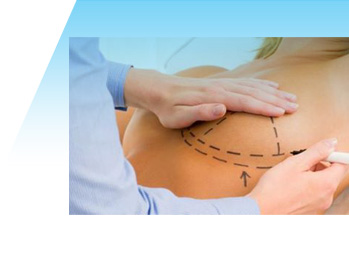Reduction mammoplasty
Breast reduction, also called reduction mammoplasty , involves removing excess breast tissue and skin, making the bust more proportional to the rest of the body. The areola (pigmented skin surrounding the nipple) can also be reduced and re-position.

Indications
Excess breast tissue, over an aesthetic problem, causes number of physical problems that affect the daily life of the patient.
• Mal d’esquena, cervical o d’espatlles.
• Back pain, neck or shoulder.
• Fallen and heavy breasts with nipples pointing down.
• Breasts too big for the body constitution.
• Skin irritation below breast groove.
• Restriction and discomfort of daily activity due to the volume and weight of breasts.
• Lack of confidence/self-esteem.
• Solve asymmetry in disproportional breasts.
• Solucionar una asimetría en el caso en que un pecho sea bastante más grande que el otro.
A breast reduction can be performed at any age, but we recommend waiting until breasts are fully developed.
First Visit
A personal visit is the first step for any woman who is thinking about a breast reduction.
Dr. Saez will ask about your general health and what your expectations are.
From an individualized evaluation Dr. Saez will explain the technique and the results that can be achieved by surgery.
Procedure
The most common technique is explained below. However, there may be slight variations depending on the physical characteristics of each person.
A scar shaped anchor (or inverted T) is generally performed by starting from the areola to the submammary. Every effort is made that the horizontal scar, which coincides with the submammary, has the least possible length.
Once the excess breast tissue is removed, areola and nipple are repositioned to the desired height and in case of a large areola a reduction can be performed. The remaining gland and skin are remodelled to get a conical and rejuvenated breast.
• The operation usually lasts between 2 and 3 hours.

Post-op care
Although each person’s recovery is different, it is common to follow the next steps:
After the operation the usual stay at the clinic is 24 hours, thereafter the patient can be discharged.
THE FIRST DAY:
• It is advisable to rest with the chest slightly lifted. You should not manipulate the bandage.
DURING THE FIRST WEEK:
• You must take moderate rest, especially the arms.
• The bandage will be removed after 3 or 4 days, and you will have to wear a special bra.
AFTER THE FIRST WEEK:
• You can progressively start to work and return to normal activity
• The stitches will be removed (although we don’t usually use visible sutures).
AFTER THE FIRST MONTH:
• Inflammation will be reduced and you will start to see the final result more defined.
• You can use an everyday bras.
• You can do more vigorous exercises.
• Scars start to blend in with the skins natural tone better over time.
• Encontrará gran alivio en la espalda, cuello y hombros gracias a la eliminación de peso en el pecho.
Results
Results achieved are maintained for many years. However, you must remember that your breasts are not immune to the effects of fluctuations in weight or age.
It is advisable to take care of skin by moisturising, and make some physical exercise.
